| |
|

Sunday, May 18 Community Israel Independence Celebration

Wednesday, May 28 JFS~Ellen Saks lecture on mental illness
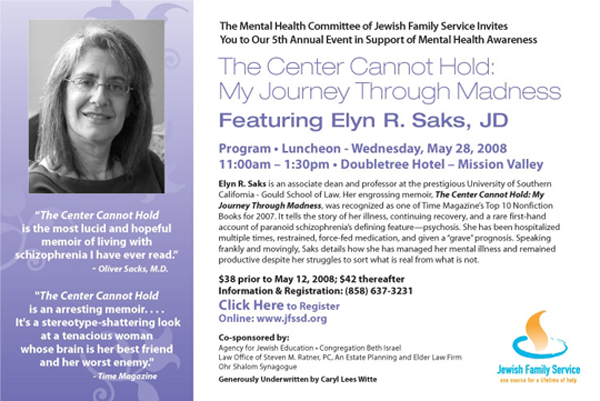

Tuesday, June 3 Guardians Golf & Tennis Tournament


Friday-Saturday, June 6-7 JFS~Judaism on the Wild Side

Sunday, June 8 Temple Solel~Tikkun Leil Shavuot


LETTER FROM JERUSALEM
Retaliation in Gaza may be a matter of political timing after Bush, Pelosi visits
By Ira Sharkansky
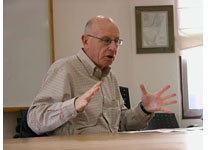 JERUSALEM—Palestinian rockets from Gaza have been falling regularly on southern Israel. One landed on a crowded shopping mall in Ashkelon, and sent about 50 people to the hospital. So far, nothing more than angry words from Israeli politicians and generals, and more of the small unit actions that have been going on for months. JERUSALEM—Palestinian rockets from Gaza have been falling regularly on southern Israel. One landed on a crowded shopping mall in Ashkelon, and sent about 50 people to the hospital. So far, nothing more than angry words from Israeli politicians and generals, and more of the small unit actions that have been going on for months.
One guess is that the IDF could not do anything dramatic until George W. Bush left the country. He is no longer in Israel, but he is still in the region. Perhaps IDF cannot wreck havoc while he is talking to the Presidents of Egypt and Palestine (West Bank). He may have been favorably inclined to Israel by seeing the rescues from Ashkelon on television while he was talking with the prime minister. His speech to the Knesset was more Zionist than we usually hear from Israelis. However, we know that he also has to express himself in favor of a Palestinian state. Real-time pictures of fallen homes and screaming mothers from Gaza will not play well on the president's memory.
Also competing for attention is the visit of a delegation from the House of Representatives, led by Nancy Pelosi. Reports are that she wept while visiting the children's exhibit at Yad Vashem, but that is unlikely to make her impervious to Palestinian suffering.
There is also continuing talk about a cease fire with Hamas and its friends, being worked on by Egypt. Some Israelis see hope in this, even admitting that a recess from violence will allow Hamas to increase its armaments and preparation for greater threats. If the cease fire in the south corresponds with a break-through in negotiations with the Palestinians of the West Bank, something like peace may really arrive with the declaration of a Palestinian state.
For this scenario, one either has to be an optimist of the most extreme kind, or beholden to a weak prime minister, when charges of corruption are making him even weaker. Ehud Olmert may be serious when he talks about the prospects of peace, or simply reaching out for something to please the American president and secretary of state, and to keep the Israeli police and prosecutors away from his door.
I perceive that my internet friends are disproportionately in favor of Barak Obama. I received a shame-on-you letter from one correspondent who reacted badly to the president's comments in the Knesset about an unnamed politician who would negotiate with the supporters of terrorism. Not too far beneath the surface was Bush's suggestion that it was Obama who would take the role of Neville Chamberlain, the appeaser of Hitler.
That was tough language, but it played well before a population that suffered from Hitler, and which may be the one national constituency in all the world (including the United States) that admires George W. Bush.
The comment did not strike me as unfair. American politics hasve not stopped at the nation's borders since criticisms of wars against Mexico and later Spain, Republicans' criticism of Wilson's proposal for the League of Nations, Roosevelt for aiding Britain, or when politicians of both parties took on the Administration when troops were fighting in Korea, Vietnam, and now Iraq and Afghanistan.
The United States negotiates (indirectly) with Iran, as Israel negotiates (indirectly) with Hamas and Hizbollah. But it is part of the political game to avoid advocating conversation with terrorists or their supporters. Obama showed that he has something to learn about the presidential craft, and left himself open to criticism of the most severe kind. Either that, or he really does think that Iran has something to offer.
The lack of a serious IDF escalation in Gaza, and the flap over the president's remarks have something in common. This region is dry tinder, always capable of igniting. This being the Promised Land important to three religions adds to the emotions. Israel's Knesset, the Yad Vashem Holocaust Memorial, and other sites attract attention. Palestinians are trying to make their Nakba into an event with international importance. Israel has to defend itself, but patience, good timing, and an awareness of political implications are never far from its calculations.
Things may change in Gaza before some of you read this note. Writing about the Middle East is almost as problematic as living here.



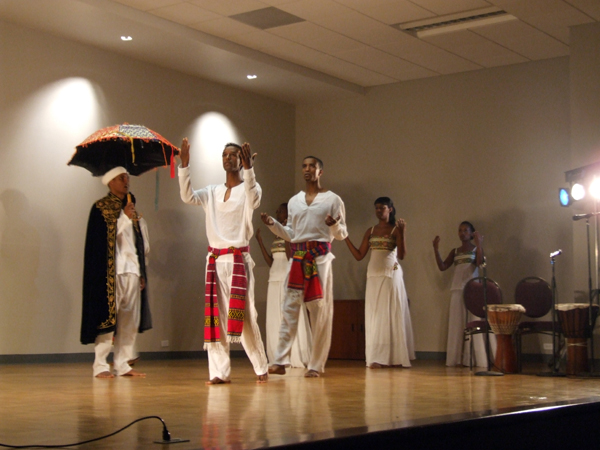
THE JEWISH CITIZEN
Night on Churchill—er, Dizengoff—filled
with new sights and shoulder movements
By Donald H. Harrison
 SAN DIEGO – In this city it is not uncommon for streets to change their names without your ever being aware of it. Traveling from the San Carlos section to the Del Cerro section of San Diego, for example, Golfcrest Drive becomes Murray Park Drive which in turn becomes Madra Avenue. So perhaps no one at nearby Tifereth Israel Synagogue was surprised on Saturday evening, May 17, when Dizengoff, the main thoroughfare of Tel Aviv, took on the aspect of Churchill Avenue, the major street of Addis Ababa, Ethiopia. SAN DIEGO – In this city it is not uncommon for streets to change their names without your ever being aware of it. Traveling from the San Carlos section to the Del Cerro section of San Diego, for example, Golfcrest Drive becomes Murray Park Drive which in turn becomes Madra Avenue. So perhaps no one at nearby Tifereth Israel Synagogue was surprised on Saturday evening, May 17, when Dizengoff, the main thoroughfare of Tel Aviv, took on the aspect of Churchill Avenue, the major street of Addis Ababa, Ethiopia.
The synagogue’s fundraiser, “A Night on Dizengoff” featured entertainment by the Beta Dance Troupe, a group of seven Ethiopian Jews, who delighted attendees with dances that included a religious processional, a courting dance accompanied by drumming, a love duet that morphed into a wedding dance, a three-woman, chair dance which choreographer Ruth Eshel has named “Opus for Heads” and a finale called “Opus for Shoulders” in which the costumes were a mix of blue jeans and Ethiopian fabrics—symbolic of the fusion between the modern era and traditional ways.
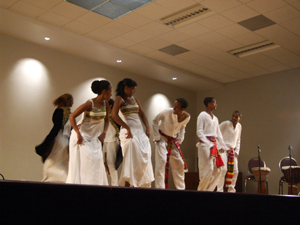 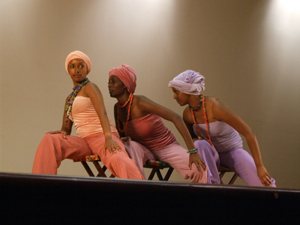
Eschel, who taught dance at Haifa University where she was artistic director for Eskesta shoulder dancers, recruited a different group of Ethiopian olim about 10 years ago when she went out on her own to form the Beta Dance Troupe, now based at the Neve Yosef community Center in Haifa.
Touring in San Diego, the group has performed at Congregation Beth El and will make an appearance again at the Yom Ha’Atzma’ut Festival at the Lawrence Family JCC.
Although many of the dances charmed, the courting dance—featuring the rhythmic movement of shoulders and heads—had many in the audience attempting what seemed an enjoyable aerobic exercise in their chairs.
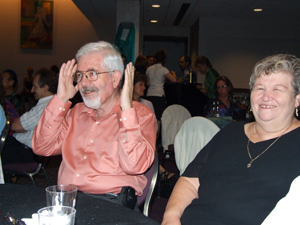 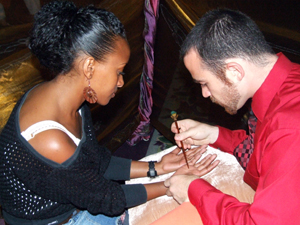
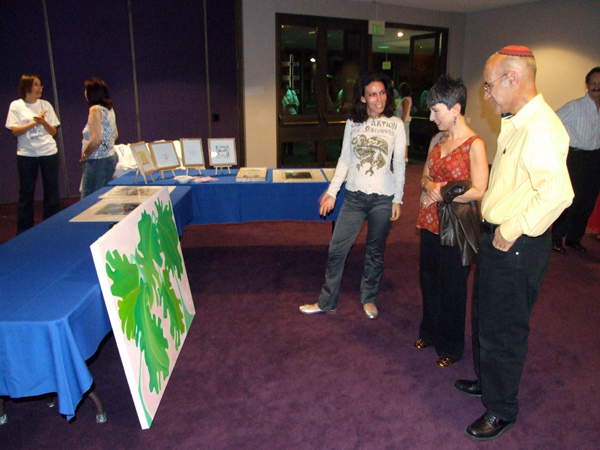
Rabbi Leonard Rosenthal, who took numerous photos of the dance performance, said it was indicative of the “breadth of Jewish culture.” Too many people make the mistake of believing that Israeli dance is only “Hava Nagila,” with people dancing in a circle, he commented.
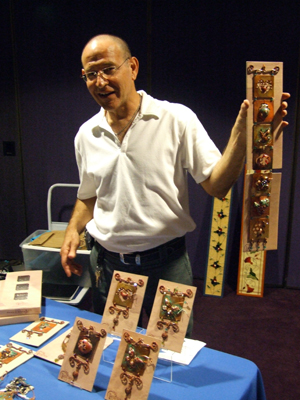 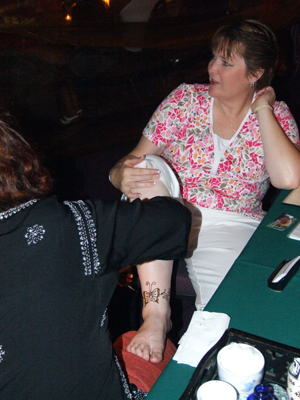
Before their performance, dancers Salomon Tapeta, Wagaw Getenh, Nir Elazar, Daniel Brahna, Minalu Daga, Ester Maharat and Maayan Raskay, enjoyed the “souk” set up in the Conservative congregation’s social hall, where vendors offered art works, henna body painting, and fortune telling, and where the $25 admission entitled one to a buffet of Israeli appetizers like hummus and borekas and an open bar.
There were also shirts for sale with the legend on the front “Can you believe I’m 60?” and on the back a map of Israel.

Nancy Harrison
cruise & tour specialist
(619) 265-0808

TORAH ON ONE FOOT
Starting Jewish studies even as an adult
By Rabbi Leonard Rosenthal
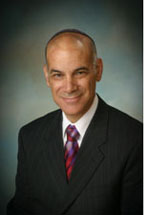 SAN DIEGO—One of Judaism's greatest scholars and teachers, Rabbi Akiva, began his life under modest circumstances. He was raised by impoverished parents and inherited his father's occupation of illiterate shepherd. He fell in love with the beautiful Rachel and married her, despite her father's threat of disinheriting Rachel if she married the poor Akiva. SAN DIEGO—One of Judaism's greatest scholars and teachers, Rabbi Akiva, began his life under modest circumstances. He was raised by impoverished parents and inherited his father's occupation of illiterate shepherd. He fell in love with the beautiful Rachel and married her, despite her father's threat of disinheriting Rachel if she married the poor Akiva.
Rabbi Akiva and Rachel had a son. When Akiva was 40 years old he decided to join his son in school. When he began to study he did not know the difference between an alef and a bet. With Rachel's help and blessing he stopped working and devoted his life to the study of Torah. He did little else but study for the next twelve years. He was soon recognized as one of Israel's preeminent sages. In 132 C.E. he became the spiritual leader of Bar Kochba's failed revolt against the Romans. He died a martyr's death after he continued to teach Torah despite the Roman prohibition.
There is a midrash explaining how Rabbi Akiva was inspired to change his life when he reached middle age. One day when he was out with his sheep he observed a rock with a hole through the center. When he took a closer look he saw that the hole had been bored by the constant dripping of water from a precipice above. He thought to himself: "If this soft water can penetrate this hard rock, then surely the constant pounding of Torah can penetrate my head!"
Rabbi Akiva is an inspiration to all of us, not only because of his fight for Jewish independence and survival, but for his willingness to begin Jewish study late in life. Although it may be difficult for an adult to learn Torah from scratch, the rewards are all the greater for the wisdom that maturity brings.


AMAZING STORIES OF JUDAISM
The Rosh Yeshiva and a 'Hebrew Christian'
By Rabbi Baruch Lederman
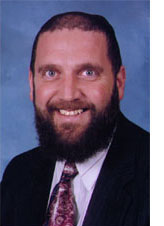 SAN DIEGO—The following piece, written by Yair Hoffman, Far Rockaway, NY was published in The Five Towns Jewish Times. Rabbi Hoffman can be reached at Yairhoffman2@gmail.com. It is dedicated for use in this column, by Yair (Jordan) & Masha Hoffman L'Zecher Nishmos his parents Dr. Nathan Hoffman a"h, who was niftar this past Shabbos, and Sarah Hoffman a"h who was nifteres last Elul. Dr. & Mrs Hoffman passionately loved what the Rosh Yeshiva stood for. SAN DIEGO—The following piece, written by Yair Hoffman, Far Rockaway, NY was published in The Five Towns Jewish Times. Rabbi Hoffman can be reached at Yairhoffman2@gmail.com. It is dedicated for use in this column, by Yair (Jordan) & Masha Hoffman L'Zecher Nishmos his parents Dr. Nathan Hoffman a"h, who was niftar this past Shabbos, and Sarah Hoffman a"h who was nifteres last Elul. Dr. & Mrs Hoffman passionately loved what the Rosh Yeshiva stood for.
A Further Glimpse of Gadlus
By Yair Hoffman
A story. Deep in the heart of Brooklyn lived a Jewish woman who, sadly, never married. She was also, r"l, dying of cancer.
While not particularly observant, this woman was proud of her Judaism. But aside from her cancer, she was deeply pained about something else. She was saddened that the link from Sinai connecting her, her parents and grandparents would be severed at her generation. The woman had one sister, who, unfortunately was intermarried. Indeed, not only did she intermarry, but she had wed a gentile leader of what was known as the "Hebrew Christian movement." This sister had one child. The child was a twelve-year-old boy who had been, alas, deeply inculcated with the heretical beliefs of his parents. The child's aunt, dying of cancer, begged her sister, "Please! I am dying of cancer. My one request of you is to allow your son to attend a Yeshiva - so that at least he will be given a chance to be exposed to the beauties and truths of his own religion."
She begged and pleaded and finally - her sister relented. In the dying woman's building lived an elementary school Rebbe who was a Talmid of Rav Henoch Leibowitz zatzal. The dying
woman had consulted very closely with this Talmid. She had finally convinced her sister about her child, but where to send him? What Yeshiva would take a twelve year old child who firmly believed in a different religion entirely? Where would he go?
On the tenth of Nissan … thousands of Talmidim across the country and throughout the world lost their beloved and precious Rebbe, Rav Alter Chanoch Henoch Leibowitz, zichron Tzaddik veKadosh Livracha - the Rosh Yeshiva of Yeshiva Chofetz Chaim in Queens. He was its Rosh Yeshiva since 1941 - lovingly guiding and instructing three entire generations of Talmidim. No other contemporary Rosh Yeshiva in America could lay claim to such a long tenure.
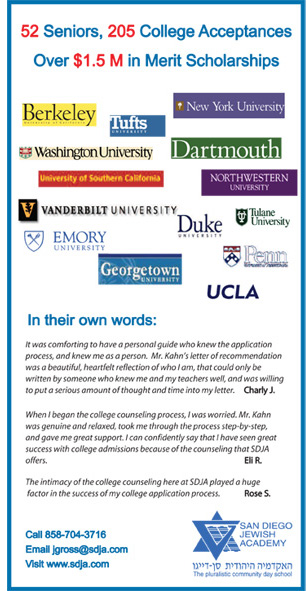 The Rosh Yeshiva's illustrious father was the great nephew of the Chofetz Chaim himself, known for his unparalled Ahavas Yisroel. His maternal grandfather for whom he was named was The Rosh Yeshiva's illustrious father was the great nephew of the Chofetz Chaim himself, known for his unparalled Ahavas Yisroel. His maternal grandfather for whom he was named was
the famed Rav Chanoch Henoch Shershevsky, a Torah sage who loved Talmidei Chachomim so much, he would literally hug and kiss them just like Chizkiyahu HaMelech used to do. The
Rosh Yeshiva clearly inherited a profound love for Talmidei Chachomim and for each and every member of Klal Yisroel.
As a Rosh Yeshiva and as an heir to the rich traditions of the Slabodka Yeshiva in Europe, he guided his Talmidim, of course, in both the subtleties of Talmudic dissection and in the
full gamut of the Mussar oeuvre - Chochmas HaMussar, the wisdom and intellectual component of Mussar; Limmud HaMussar BeHispaalus, studying Mussar in an emotional way allowing its concepts and ideals to affect our own personal behavior, and Chinuch HaMussar, the practical implementation of the concepts of Mussar in our daily life. He demonstrated and made practical the notions of Limmud HaMussar with Sfasayim Dolkos - lips aflame.
He made it a point to join his Talmidim in this particular Seder, the Mussar Seder, in Yeshiva whenever he could. The highest ideal in his Yeshiva was to be a Baal Mussar- a master of Mussar. This Rav Leibowitz ingrained in the heart of each of his students. But there was something even greater in his instruction. Something deeper and more profound.
 Rav Leibowitz combined his loving instruction with unparalleled insights in Hashkafa - the proper Torah outlook that all Bnei Torah should have. He did it using two mediums of instruction - theory and practice: The theory - involved actual Hashkafa sessions that took place at times in his Blatt shiur. In these sessions Rav Leibowitz spelled out the hashkafic ideals of Torah Judaism. The practice - involved his personal actions and deeds. Rav Leibowitz combined his loving instruction with unparalleled insights in Hashkafa - the proper Torah outlook that all Bnei Torah should have. He did it using two mediums of instruction - theory and practice: The theory - involved actual Hashkafa sessions that took place at times in his Blatt shiur. In these sessions Rav Leibowitz spelled out the hashkafic ideals of Torah Judaism. The practice - involved his personal actions and deeds.
His Talmidim saw and heard the "theory" and the "practice" - and both deeply impacted them all.
Some of the Hashkafos differed substantively from what one would call the "conventional wisdom." An example might be "the Role of a Yeshiva." I remember vividly one such "theory"
discussion.
Rav Leibowitz began with an explanation of the role of a loan officer in a bank. He explained that the loan officer with a perfect record of never having made a bad loan was actually not doing
the bank any favors at all. He was obviously being too conservative in his role and not maximizing profits for the bank. A loan officer that makes loans at 6% interest with a perfect record of no defaults is not as valuable to the bank a loan officer
who makes loans at 10% with a 1% default record .
"A Yeshiva is, lehavdil, der zelbe zach," he said He continued, "Anyone can establish a Yeshiva with 100% frum Talmidim with good hashkafos. The Chochma is in reaching out to others too
while maintaining the proper mix." He further honed his message by explaining that the role of a Yeshiva is to ensure that the atmosphere and ruach permeating its halls, classrooms,
and recess yard is one of true Torah growth. "What makes up this atmosphere and ambiance? ," he would ask.
"It is the combination and delicate balance of three factors: 1] inspired and dynamic teachers and Rebbeim 2] the mix of the student body, and 3] the inspired leadership of administration. The Yeshiva leadership must carefully weigh, balance, and readjust this delicate combination to ensure that the atmosphere prevailing in the air of the Yeshiva is one of growth and inspiration."
But the goal and role of a Yeshiva is not to provide Chinuch to just our children. It is to do the Ratzon Hashem and to be the vehicle in which we can fulfill our thrice daily recited Mitzvah of
VeAhavta es Hashem Elokecha Bechol Levavcha uvechol Nafshecha uvechol Meodecha. In other words, like the aforementioned loan officer, the goal is to maximize profits to Hashem - anything less is an abnegation of the Mitzvah of Ahavas Hashem and an undermining of the true role of what a Mossad of Chinuch is all about .
The Rosh Yeshiva was not just referring to out-of-town Yeshivos. He was referring to the very heart of Jewish Torah communities. "And the Talmidim and talmidos will grow even more from it.."
One might think that this was pretty heady stuff for naïve, unworldly Talmidim to make a part of their Torah outlook. But they did. They all did. And it affected the future policies of many,
many Mosdos of Torah in which these Talmidim took leadership roles. This is a vivid illustration of a Torah leader "planting seeds" that soon "turn to saplings" and later into "great oaks."
But that was "theory." What of "practice?" Let's go back to our original story. Where would his child go to Yeshiva? What Yeshiva would accept a boy from an entirely different religion?
Enter Rav Leibowitz zatzal. He told his Talmid to reassure the dying woman and that he would take him into his ninth grade. He would set the boy up in the dormitory, and would arrange that the
boy learn with Kollel yungeleit Chevrusos here and there. In short they would do their best to try to get the boy back on track - a daunting, and in all probability, impossible task.
The boy came.
Although it was clear that the boy would have no negative influence on anyone, I decided to ask Rav Leibowitz about the decision to take the child in.
"Rebbe," I asked, "At best there is a twenty percent chance of success here. After the promised year, in all probability the boy will return to the concepts that he, in essence, drank with his
mother's milk, and end up a leader in that Hebrew Christian movement himself. He eventually may even brag, 'Sure! I even learned in the Chofetz Chaim Yeshiva!' Isn't the Rosh Yeshiva
concerned about this possible eventuality?"
He responded, "Yes, I am very concerned about it. But we have to do it. Both for the sake of the boy's aunt and for the boy himself." A personal lesson in the practice of Chinuch - not just
the theory. The story did not end positively- but not for lack of trying . Rav Henoch Liebowitz zatzal practiced enormous mesiras nefesh for Chinuch. All his students saw it. And the fact
that he was concerned for this cancer patient and her nephew spoke volumes to us all. In one Shabbos afternoon Mussar Shmuess he spoke of the famous business practices of some
rural restaurants having two different sets of menus: One for the business traveler passing through - the proverbial big spender who can afford big city prices. The other menu was for the locals who needed the local restaurant but could only afford more modest prices. So the restaurants often have two menus.
"We also have to have two menus, so to speak- two standards of behavior. One standard is what we expect of ourselves.
"Pass someone in the street without saying good morning? - Chas VeShalom! We would never do such a thing. The other person is a tzelem elokim. How could we ever infringe upon that
by not saying good morning or hello?"
And the Rosh Yeshiva expounded upon the flip side. "Someone didn't say good morning or hello? Chas VeShalom to be upset! It is not a big deal if they don't say hello or good morning - people are busy and preoccupied. We are a tissue-paper generation if we get upset about such things."
Two menus. Two standards of behavior. Mussar thought dictates that we cannot extrapolate one to the other. We must hold ourselves to a different standard of behavior and never correlate the two. Most people, of course, do correlate the two. "This is what I expect of both myself and of others," is a common refrain. The Rosh Yeshiva zatzal, however, taught otherwise and demonstrated that it was, in fact, a Mussar obligation. Rav Leibowitz inspired his students to grow in their Mitzvah observance and in their midos with the depth and profundity of his Shmuessin. One Shavuos he spoke of how the Targum Yonasan disscusses the two components of Boaz's message to Rus: Boaz noted how Rus, a former Moabite princess left it all and converted to Judaism. He also noted the tremendous chessed she did with her mother-in-law. Boaz, apparently, equated the two.The Rosh Yeshiva asked, "How could it be? Imagine Princess Diana leaving all the wealth and glamour to join the Jewish nation as a poor indigent convert in need of tzedaka. Imagine the zchus generated for her in Shamayim. How could this supreme act be equal to chessed with one's mother-in-law?" The answer he gave was that there is infinite depth to any Mitzvah. Chessed can be performed on many, many levels. The more we put into the chessed - the greater the level. And yes, it could often be equal with the most remarkable act of self-sacrifice.
The Talmidim heard this and were inspired. Rav Leibowitz often said that inspiration must be intellectual not emotional. Emotional inspiration and exuberance are often associated with the exuberance of youth and tends to tone down after a few years. Not so intellectual inspiration. Intellectual inspiration remains even once one has matured beyond the exuberance of youth. When the Rosh Yeshiva spoke publicly for Baal HaBatim he often had a dynamic emotion loaded presence that was absent when he spoke to the Bnei HaYeshiva. When quizzed about this, he responded that it was done purposefully - to provoke within his Talmidim intellectual inspiration in its purest form as opposed to emotional inspiration. Hashkafic topics broached quite a range of topics: from Daf HaYomi - to poker - to how best to learn
Gemorah in Bekiyus Seder, and how all these topics affected and effected one's ability to delve and learn BeIyun. And the Rosh HaYeshiva certainly loved Iyun. He loved to teach his Talmidim how to unfold the latent processes of reasoning in a Rashi. His questions still resonate in the minds of his Talmidim decades after having left the Yeshiva. "Rashi invokes the term 'Klomar.' Klomar always means that there is another manner in which to understand the Gemorah that Rashi rejected.
What was that other manner and what factors caused him to reject it? Did the Baalei Tosfos reject it too? What is the difference between Tosfos's two answers as seen in the Ee Nami? What is the point of contentionbetween these two answers? The Talmidim saw him remove his jacket and roll up his sleeves when delving in a difficult Rishon. He did this to show that Iyun wasserious business and one had to work hard at it. But the Rosh HaYeshiva went beyond this, and often employed boxing terminology in explaining, for example, a difficult Rashba. (Interestingly enough, Rav Shach zatzal used to employ boxing terminology as well.) The Rosh Yeshiva placed extraordinary stress on the halachos of Lashon HaRah, even maintaining for the Bnei HaYeshiva a twice weekly seder in Sefer Chofetz Chaim.
He had also mastered every nuance of every Be'er Mayim Chaim and kept to all the halachos very rigidly.And then I saw it in practice. Many years after I had left the Yeshiva a friend of mine possessed an advance copy of a book about the Torah world of Europe. I was loaned the copy (the friend was the author's cousin) and while reading it discovered that it had quite a huge amount of material on the Rosh HaYeshiva's father, Reb Dovid. I told the Rosh Yeshiva about the book and saw his utter excitement about reading about his father. He was emotional about it and I felt a remarkable z'chus in being able to give such nachas to the Rosh Yeshiva by giving him the book. I then joked that the Rosh Yeshiva should finish reading it quickly because no doubt the book was destined to be put in Cherem. He asked me why, and I explained that there was material in it that should not have been included. The Rosh Yeshiva then refused to take the book so as not to be nichshal in the aveirah of Lashon HaRah, Chas VeShalom. I had forgotten that I was standing before a Gadol HaDor and could not imagine what I was thinking.
In his Shmuessin he would often employ the Slabodka methodology of deeply examining a Chazal, comparing what we know of the subject matter, drawing out a logically and textually compelling insight, but then he stopped short. He did not make the application - that crucia lnext step in the process where the ethical lesson is applied to oneself. Why didn't he? He once answered that he wanted us to make the applications ourselves.
Spoon-feeding it to us would remove a very important component. The realization of its application must come from within or the power of the message is lost. [In the same vein, Rav Dessler explains that Moshe Rabbeinu only hinted to the Klal Yisroel that they should prayfor his entry into Eretz Yisroel. Had he out and out told them, the prayer would not be efficacious. It must come from within].
He knew each of his Talmidim quite well. He would often describe the Alter of Slabodka as a master pedagogue who knew the inner workings and specific talents of each of his Talmidim. The Rosh Yeshiva zatzal shared this ability, although in his humility he would never admit to it. At every Simcha of one of his Talmidim where he was asked to speak he would hone in on the Middah that most represented the Talmid. He gave Shmuessin on Wednesdays and on Shabbos. On Wednesdays he would hone in on what he perceived was a particular need that the Bnei HaYeshiva should work upon. He once asked what the definition is of a "Baal Chesed." I vividly remember his answer. He said, "A Baal Chesed is what most people would call "a sucker." He was clearly addressing some lacunae that he had detected in someone, and wanted to quietly disabuse that Talmid of his misperception.
On Shabbosim his Shmuessin took a slightly different turn. This was the time where he would amass his vast repetoire of other Shmuessin said throughout four or five decades and compare and contrast the subtleties of the various closely related insights. Few were those who grasped every point in its entirety. But that was why there was something called "Chazaras HaShmuess" - where the students could review what they had missed.
His lifelong friend, confidant and partner of course was his beloved Rebbitzen, Rebbitzen Pesha Leibowitz a"h, who had passed away in 2002. She was a granddaughter of HaRav Naftoli Trop, the Rosh Yeshiva in the Chofetz Chaim's Yeshiva in Radin. Rebbitzen Leibowitz a"h was apedagogue in her own right as well. She had taught many Talmidos at Rav Meir Levi's Bais Yaakov in Brooklyn. In many ways she served as his eyes and ears.
Aside from her role as Rebbitzen, she was a mother to the entire Bnei HaYeshiva. I recall when an older roommate of mine had spray-painted something a bit bizarre on the back wall behind the dining room. His tenure in Yeshiva was not something people would have bet on, but it was the Rebbitzen who saved him. Now he is a choshuva Talmid Chochom and Marbitz Torah in Klal Yisroel.
Her wisdom and insight were held in the highest esteem by the Rosh Yeshiva. After she passed away the Rosh Yeshiva spoke quite emotionally of how deeply he loved her and how she was everything to him. They lived on Groton Street in Forest Hills for over forty years, a home that they kept open for their thousands of Talmidim. [Later, the Rosh Yeshiva remarried to Rebbitzen Daniella Leibowitz yblct, who was also an enormous help to her husband.]
The Rosh HaYeshiva is buried next to his Rebbitzen of nearly all his life in the Tifereth Jerusalem section of the Mount Judah Cemetery in Cypress Hills, Queens, off the Jackie Robinson Parkway.


DOING IT BETTER
What to do with those old family photos
By Natasha Josefowitz, PhD
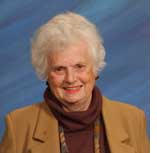 LA JOLLA, California—My mother died in 1999 at age 96 leaving twenty plus photo albums besides all the notes taken on her trips, notes on every book she ever read and on all the countless classes she attended. All the latter I could toss, but the photo albums have been staring at me these past eight years, until on my last trip to London to visit my son, I packed them all so he could help me decide which photos he wants for the generations to come. We did the deed. LA JOLLA, California—My mother died in 1999 at age 96 leaving twenty plus photo albums besides all the notes taken on her trips, notes on every book she ever read and on all the countless classes she attended. All the latter I could toss, but the photo albums have been staring at me these past eight years, until on my last trip to London to visit my son, I packed them all so he could help me decide which photos he wants for the generations to come. We did the deed.
As he leafed through the disintegrating pages and the fading pictures, he put Post-its on the ones he wanted. Then it was up to me to pull out these as well as ones for my daughter and brother and various cousins whose faces appear among many unfamiliar ones.
The early pictures had these little corners holding them down, then came the double-sided scotch tape which made the photos tear unless we used a knife, and finally the easy ones to pry out with the plastic sheets covering each page.
The photos from the twenties and thirties: sepia, posed stiffly for the photographer in proper clothes, and unsmiling faces. The forties: in black and white, small-format glossies with tiny, unrecognizable people taken with early cameras that unfurled like accordions. By the fifties, we had color and decent portraits.
How interested would the grandchildren be? My grandson remembers my mother, but how meaningful are the photos of her parents? The strange man with the handlebar mustache, the woman with hair piled high, with ever more distance from their eventual great grandchildren. Is all this keeping alive of ancestors worth the effort? I look at them in wonderment, looking for a similarity to me or my children and not finding any. My nostalgia begins with my own children, so dear when tiny, so cute growing up, I miss those years when I look at these people, taller than I, who don’t really want my advice; of course, it’s because they know better….
The choice of settings also has changed—then, photos were taken mostly on trips, endless beaches and snowy mountains. It’s either old-fashioned bathing suits or long, wooden skis. There are shots of horseback riders with the appropriate jodhpurs or golfers with knickers and cleated shoes. Later, the backgrounds change to more exotic fares: Chinese Buddhas, Egyptian pyramids, the Yangtze, the Nile, the Amazon, leaning towers, blue icebergs, vine-encrusted temples in the heart of Cambodia, poor villages with naked, black children or Aborigines with kangaroos.
It’s either that or more homescapes, the living room, the kitchen, the backyard with children splashing in the inflated wading pool.
My mother at thirteen, my daughter at thirteen, my granddaughter at thirteen, perhaps I should put these next to each other instead of chronologically. We compare my son at eighteen and my grandson at eighteen—we marveled—it is the same face.
There are several options on what to do with all these photos. Some people swear by DVD’s—one can send them to all the relatives, but I fear you look at them once and that is it. Placed into photo albums is the usual choice, but it’s tedious work. And finally, the option I will choose, oversized shoeboxes from photo stores with cardboard dividers by years—just be sure to write on the back who, when and where.
And yet, there it is, the silent witnesses of a life well-lived, of children grown into good adults, of MBAs and PhDs, of homegrown teachers lawyers, doctors, and engineers, of failures, survivals and triumphs.
A whole lifetime—no regrets!
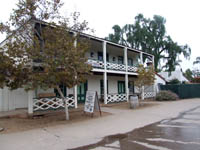
Robinson-Rose House
|
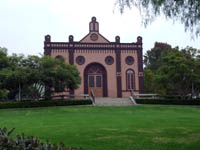
Old Temple Beth Israel |
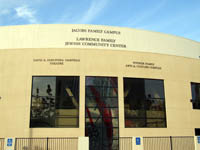
Lawrence Family JCC |
Editor's Note: We are reprinting news articles that appeared in back issues of various San Diego Jewish newspapers. You may access an index of the headlines of those articles by clicking here. You may also use the Google search program on our home page or on the headline index page to search for keywords or names.
Goal of Reopened Campaign to be 1949 Figure
From Southwestern Jewish Press, August 18, 1950, page 1
Goal of the United Jewish Fund Campaign, which will be reopened in late September, will be $25,000, according to Victor Schulman, president of the United Jewish Fund.
“We have to date missed our expectation of $205,000, which was raised in 1949, by $25,000,” Schulman stated. “We know that this money is in our community, and can and must be secured from those who have not given enough in 1950, and from those who for one reason or another have not as yet made their contribution to this great cause.”
There are now about 300 individuals who pledged in 1949 but who have not made any pledge in 1950. These are residents of San Diego County, who have not yet joined those who are sharing the responsibility. They still remain on the sideline. The job of the workers in the reopened campaign will be to bring them into the game. Their nonparticipation will cause the effort of the San Diego Jewry to do a good job to meet with failure.
The Campaign Committee, under the leadership of Murray D. Goodrich and Nathaniel Ratner, general co-chairmen and Selma Getz, Women’s Division chairman, will meet to make plans for a short and effective campaign. Mrs. Getz urged all of the women who have not as yet given to make a contribution, no matter how small. She said, “We sit here in our security and comfort and we talk easily about success or failure of a campaign. But what about 75,000 Jews who cannot get out of Europe because the JDC does not have the funds to help them immigrate? What about those immigrants in Israel who suffer misery and squalor? What about our own local agencies which need funds? We must provide them with those funds.”
The campaign picture, according to the leaders of the drive is not at all black. More contributions have been secured in the 1950 campaign than in 1949 or 1947. More volunteer workers and generous contributors who have worked and given far beyond their share have been developed in this year. The only black parts of the campaign are those who continue to shirk their responsibility either out of pettiness, spite, or greed.
The United Jewish Fund, having faith in the community, is appealing to all who have not yet done their share to stop waiting, and make their contribution.
The J.C. Camp at Palomar
From Southwestern Jewish Press, August 18, 1950, page 4
By Paul Kaufman
Early on the morning of July 31st a large, yellow bus, carrying children and a few apprehensive counselors, left Temple Beth Israel Center for the Jewish Community Camp in Palomar.
After driving over mountain roads with breathtaking curves, through forests of unrivaled beauty, we arrived by lunchtime at our destination. The remainder of our first day was spent fixing the tents and getting acquainted with the beautiful surroundings.
The balance of our stay at the JC Camp was filled with the many interesting activities of camp life such as fishing, hiking, and athletics, plus movies and campfires at night. The most wonderful thing about the camp was the spirit of cooperation which prevailed all during our stay. We are all looking forward to our next camping trip.
Mr. and Mrs Al Hutler did everything to make our stay enjoyable and a vote of thanks is due them.
Hebrew Home for the Aged
From Southwestern Jewish Press, August 18, 1950, page 8
Mrs. Saul Chenkin wishes to announce that Mrs. Rose Anderson has been appointed supervisor for the Home. Any matter regarding the Home should be discussed with her. She can be reached at the offices of the Jewish Welfare Society, 333 Plaza Bldg., F-1803.
The Home has become the center for the aged in town and is the scene of many parties.
Guests of the Home were pleasantly surprised by the gift of a 16th television set from the Women’s Auxiliary. This was made possible by the money that was raised especially for this purpose.
Women’s Auxiliary—The Women’s Auxiliary of the Home is planning its first meeting of this year to be held in the garden of the Home on September 6th at 12:30 p.m.
Officers and new members of the Board will hostess the afternoon. There will be a Luncheon Koffee Klotch followed by a social afternoon with cards and Mah Jong. All newcomers and members of the Auxiliary are invited.
The Auxiliary is planning a series of birthday parties this year to honor the guests at the home on their respective birthdays. All money contributed to the Happy Day Fund will be used for this purpose. Mrs. Edward Bland is chairman of the Happy Day Fund and Mrs. Ben Harris is co-chairman. Any contributions made to the fund may be sent to them.
The Happy Old Times Club will meet again this season. Any person over 65 who wishes to join may do so by calling the Chairman, Mrs. Saul Chenkin at R06155. Dues are $1.00 per year and all residents of San Diego are eligible to join whether they reside at the Home or not.
{Return to top}

SAN DIEGO JEWISH WORLD THE WEEK IN REVIEW
Ulla Hadar in Kibbutz Ruhama, Israel: The daily hell on Israel's side of Gaza line
Donald H. Harrison in San Diego: Walk through 4 centuries of S.D. history
Sheila Orysiek in San Diego: Chapter Eight in the serialization of her novel, Reluctant Martyr
Adventures in San Diego Jewish History: What was the Jewish community news in 1950? Who were the newsmakers? Our archives answer these questions in daily installments
Donald H. Harrison in San Diego: SDJA 10th grader breaks CIF seasonal strike out record, besting even David Wells' mark
Rabbi Dow Marmur in Toronto: Gay clergy issue prompts some Canadian congregations to leave United Synagogue
Hal Wingard in San Diego: His songs, "Sara," "Makhtesh Ramon," and "At the Jerusalem Wall"
Adventures in San Diego Jewish History: What was the Jewish community news in 1950? Who were the newsmakers? Our archives answer these questions in daily installments
Donald H. Harrison in Chula Vista, California: XLNC-1, TICO helping tore-popularize and internationalize classical music
Ira Sharkansky in Jerusalem: Intolerable situation on the Gaza border
Adventures in San Diego Jewish History: What was the Jewish community news in 1950? Who were the newsmakers? Our archives answer these questions in daily installments
Judy Lash Balint in Jerusalem: Pollard, Jewish identity and the drosh — subjects on a Jerusalem evening stroll
Donald H. Harrison is San Diego: Leftover matzah is no cocktail cracker
Sheila Orysiek in San Diego: City Ballet tilts and wins with Don Quixote
Fred Reiss in Winchester, California: Book examines biblical interpretations
Adventures in San Diego Jewish History: What was the Jewish community news in 1950? Who were the newsmakers? Our archives answer these questions in daily installments
Shoshana Bryen in Washington DC: Europe is fatigued by moral issues like the Holocaust, Israel's existence
Donald H. Harrison in San Diego: Chabad Jewish Center, St. Therese Catholic Church share history, but not theology
Sheila Orysiek in San Diego: A 'New Look' is something I don’t need
Gary Rotto in San Diego: Here's how consumers can help eliminate Americans' dependence on foreign oil
Eileen Wingard in San Diego: Felder portrays Beethoven the man and Beethoven the musician at Old Globe
Adventures in San Diego Jewish History: What was the Jewish community news in 1950? Who were the newsmakers? Our archives answer these questions in daily installments
< BACK TO TOP
|
|
